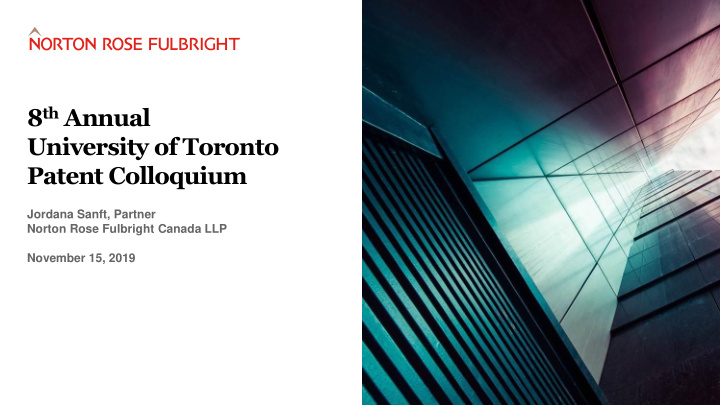



8 th Annual University of Toronto Patent Colloquium Jordana Sanft, Partner Norton Rose Fulbright Canada LLP November 15, 2019
Outline 1. Introduction to Inducement to Infringe – The three-prong test – Leading cases 2. Recent Developments in Inducement to Infringe – Inducement to induce – Common design – Is ‘but - for’ causation required – Claim scope 2
Patent infringement - Inducement Three-prong test: • (1) The act of infringement must have been completed by a direct infringer; • (2) The completion of the act of infringement must be influenced by the acts of the alleged inducer to the point that, without the influence, direct infringement would not take place; • (3) The influence must knowingly be exercised by the inducer, that is, the inducer knows that this influence will result in the completion of the act of infringement. Corlac Inc. v. Weatherford Canada Inc. , 2011 FCA 228 at 162. 3
Patent infringement – Inducement (cont.) Windsurfing International Inc. v. Trilantic Corporation (now BIC) * • Patent related to a “wind - propelled” apparatus (i.e., a sailboard) • Defendant argued that it did not infringe the patent because it did not sell sailboards in an assembled form • Plaintiff argued the defendant is clearly selling parts for the purpose of making a sailboard, including instructions to assemble • To suggest that a patent infringement suit can be successfully avoided by selling parts as components of a kit in contradistinction to their sale assembled is, according to the court, errant nonsense. * (1985), 8 CPR (3d) 241 (FCA). 4
Patent infringement – Inducement (cont.) Weatherford Canada Ltd. v. Corlac Inc. * (1st Trial / FCA 1) • Claim in issue covered a method for restraining oil which involves monitoring a leak passage to determine when seals fail • Trial judge found that it was common sense that sales were made to customers and that customers were more likely than not to follow the instructions in the manuals • Federal Court of Appeal found that the trial judge had not applied the three- prong test for inducement – remitted on issue of infringement re claim 17 * 2010 FC 602, aff’d in part 2011 FCA 228 , leave ref’d [2011] SCCA No. 418; 2012 FC 76 (remitted on infringement), rev’d 2012 FCA 261; 2018 FC 565 (remitted on infringement), appeal in A-244-18. 5
Patent infringement – Inducement (cont.) Weatherford Canada Ltd. v. Corlac Inc.* (2nd Trial) • The trial judge in the second trial found that the FCA had upheld his decision that the manual instructs the practice of the method of the patent claim • Trial judge found end users would have followed the manual and thereby infringed the patent Weatherford Canada Ltd. v. Corlac Inc.* (FCA 2) • The FCA found that it had not been determined in the first place that the manual instructs the method of claim 17 of the patent • FCA sent the case back to the trial judge again to make this determination * 2010 FC 602, aff’d in part 2011 FCA 228, leave ref’d [2011] SCCA No. 418; 2012 FC 76 (remitted on infringement), rev’d 2012 FCA 261; 2018 FC 565 (remitted on infringement), appeal in A-244-18. 6
Patent infringement – Inducement (cont.) Weatherford Canada Ltd. v. Corlac Inc. (3 rd Trial/FCA) • The case was sent back again to the trial judge for the second time (so third trial), specifically in respect of claim 17 • Now styled Grenke v. DNOW Canada ULC • The trial judge found: – [14] …it would be obvious to a person of ordinary skill in 1994 that the operating instructions provide the functional equivalent of the method of checking for leaks using passages as described in Claim 17. – [15] …customers who purchased the Defendants’ infringing products would use them in accordance with the operating and maintenance manual provided for the end user oil companies. • The third trial decision was appealed and is now pending (see 2018 FC 565 and A-244-18) • According to the court docket it is set down for a hearing on November 25, 2019 at 9:30 AM in Toronto 7
Patent infringement – Inducement – Recent Developments Recent developments in inducement law • Does inducement to induce infringement exist in Canadian law? Maybe. See Elbit Systems Electro-optics Elop Ltd. v Selex ES Ltd. , 2016 FC 1129 • Is a single direct infringer required to satisfy the first prong of the three-part test in Weatherford ? Maybe. See Packers Plus Energy Services Inc. v Essential Energy Services Ltd. , 2017 FC 1111 (aff’d on other grounds 2019 FCA 96, leave to appeal to SCC sought) • Does infringement by common design/acting in concert exist in Canadian law, and is it compatible with inducement? Arguably, yes. See Genentech Inc. v Celltrion Healthcare Co., Ltd. , 2019 FC 293 and N. Siebrasse , “Contributory Infringement in Canadian Law” (2019 ) 8
Patent infringement – Inducement- Recent Developments Recent developments in inducement law • Is ‘but - for’ causation really required to establish inducement? Good question... See N. Siebrasse, “Is ‘But for’ Causation Necessary to Establish Inducement?” (April 25, 2019) • Can inducement turn on more than just the product monograph in pharmaceutical patent cases? Yes. See Genentech, Inc. v Amgen Canada Inc. , 2018 FC 694 • Can claims drafted as “a composition for use in the treatment of” be infringed directly by a maker of generic medicines, rather than by inducement? It’s reasonably arguable — stay tuned. See Eli Lilly Canada Inc. v Apotex Inc. , 2019 FC 884 9
10
Law around the world nortonrosefulbright.com
Recommend
More recommend